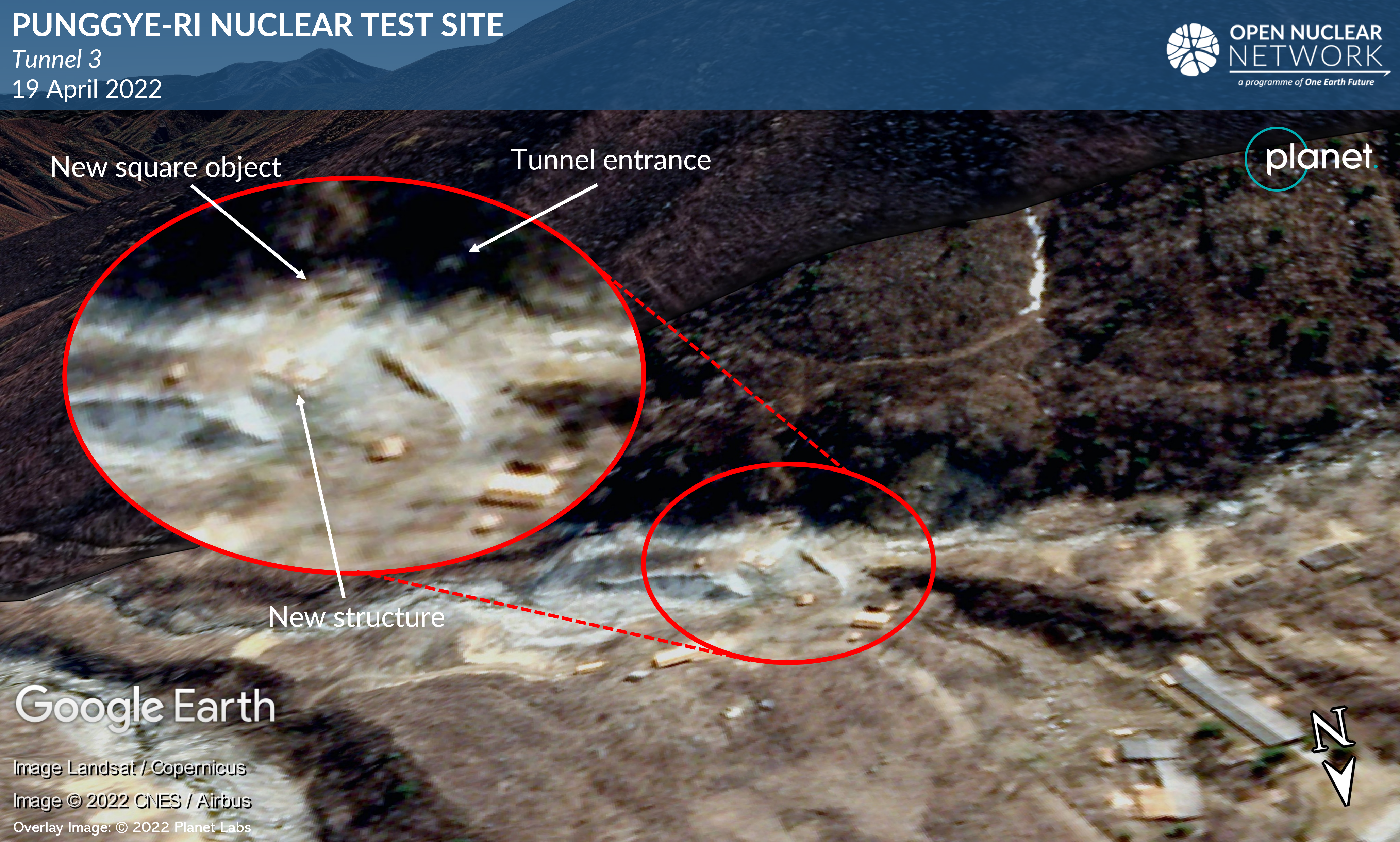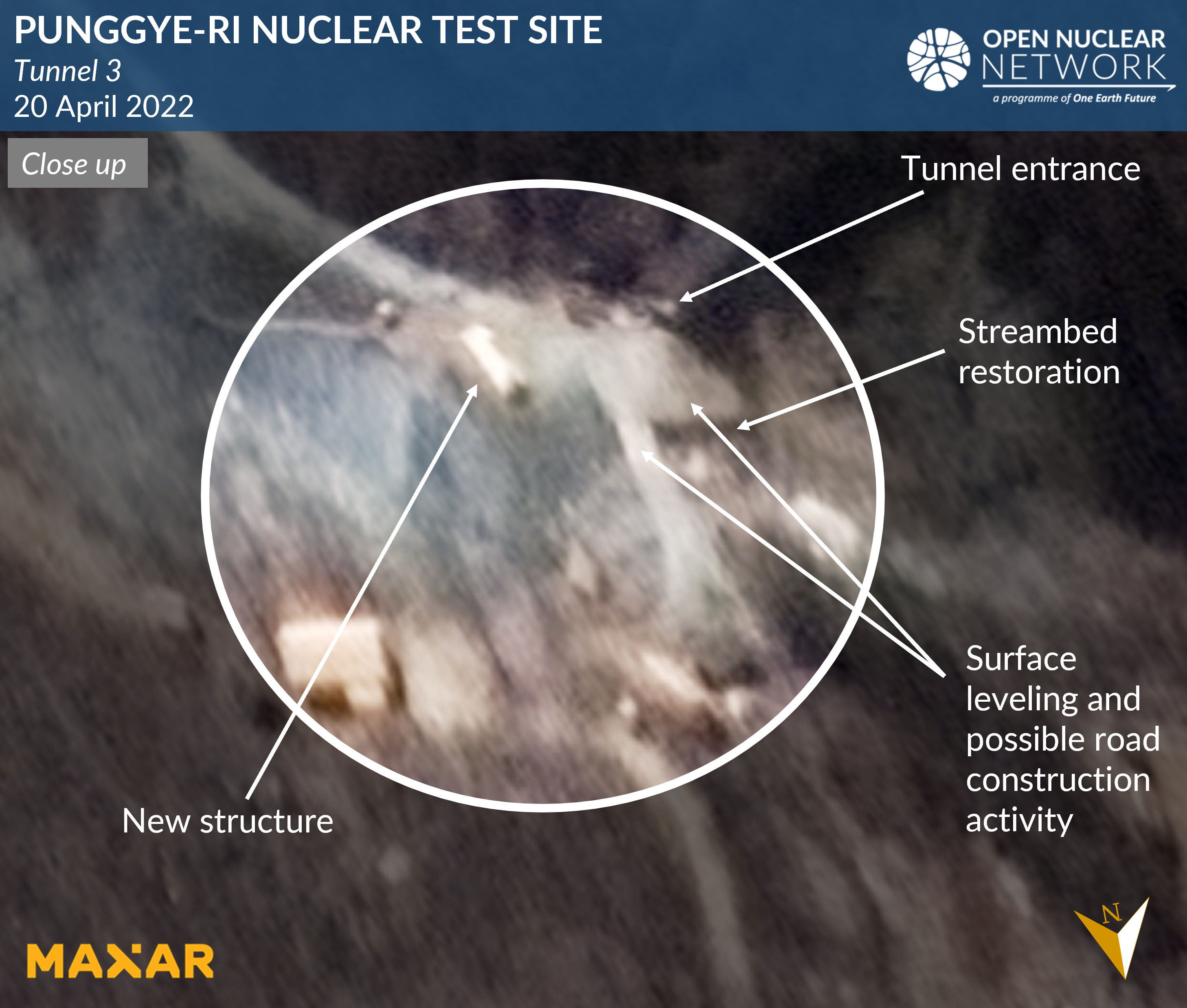In previous publications dated 28 March, 6 April and 14 April 2022, ONN reported signs of increasing activities within the Punggye-ri nuclear test site of the Democratic People's Republic of Korea (DPRK), especially at the secondary entrance to Tunnel 3 (also known as the South Portal). [1]
New satellite images from 19 and 20 April 2022 showed further developments at this site, including the following (Figures 1-3):
Tunnel 3
Recent images suggest that the area in front of the secondary entrance to Tunnel 3 has been expanded and that the ground has been leveled. Further tunneling activities may require the introduction of additional heavy vehicles or instrumentation support, for which a reinforced surface area could be required. No evidence was identified showing expansion of the spoil pile near the secondary entrance since the last report; this may indicate that Tunnel 3 excavation activities have slowed or stalled.

Figure 1: Area in front of secondary entrance to Tunnel 3 as of 19 April 2022, overlaid on Google Earth and draped over Google Earth's terrain model. Overlay image: © 2022 Planet Labs. All Rights Reserved. Reprinted by permission.
Specifically, the following new developments near the secondary entrance to Tunnel 3 have been observed since 14 April 2022:
-
New structure at a location previously used as a dumping point for newly excavated spoil;
-
Surface leveling and possible road construction activities;
-
New square object visible as of 19 April 2022, assessed as possibly an awning; and
-
Signs of streambed restoration, perhaps for flood control during the rainy season. [2]

Figure 2: Close up of the area in front of secondary entrance to Tunnel 3 as of 20 April 2022. Image: © 2022 Maxar Technologies. All Rights Reserved. Reprinted by permission.

Figure 3: Comparison of the area in front of secondary entrance to Tunnel 3 as of 19 September 2014 and 20 April 2022. Image left: Google Earth; Image right: © 2022 Maxar Technologies. All Rights Reserved. Reprinted by permission.
Main Administrative Area
Visible changes to previously noted log piles suggest that renovation activities are ongoing, albeit at a slow pace relative to recent construction in the area.
Tunnels 1, 2 and 4
No excavation nor other noteworthy activity has been observed in satellite imagery available as of 20 April 2022 at Tunnels 1, 2 and 4 (also known as the East Portal, the North Portal and the West Portal respectively).
[1] Katsuhisa Furukawa, Developments at the DPRK's Punggye-Ri Nuclear Weapon Test Site since December 2021, Open Nuclear Network, 28 March 2022, available at: https://opennuclear.org/publication/developments-dprks-punggye-ri-nuclear-weapon-test-site-december-2021. Katsuhisa Furukawa and Jaewoo Shin, Update: Developments at the DPRK's Punggye-Ri Nuclear Weapon Test Site Between 24 March and 6 April 2022, Open Nuclear Network, 6 April 2022, available at: https://opennuclear.org/en-gb/node/1638. Jaewoo Shin and Katsuhisa Furukawa, Update: Developments at the DPRK's Punggye-Ri Nuclear Test Site Between 6 and 14 April 2022, Open Nuclear Network, 14 April 2022, available at: https://opennuclear.org/publication/update-developments-dprks-punggye-ri-nuclear-test-site-between-6-and-14-april-2022
[2] Peter Makowsky, Frank Pabian and Jack Liu, North Korea's Punggye-ri Nuclear Test Site: Evidence of Typhoon Damage, 38 North, 24 September 2020, available at: https://www.38north.org/2020/09/punggye092420/. 38 North, Preparations for a Possible Third Nuclear Test Continue; Complications from Water Buildup?, 38 North, 27 December 2012, available at: https://www.38north.org/2012/12/punggyeri122812/
